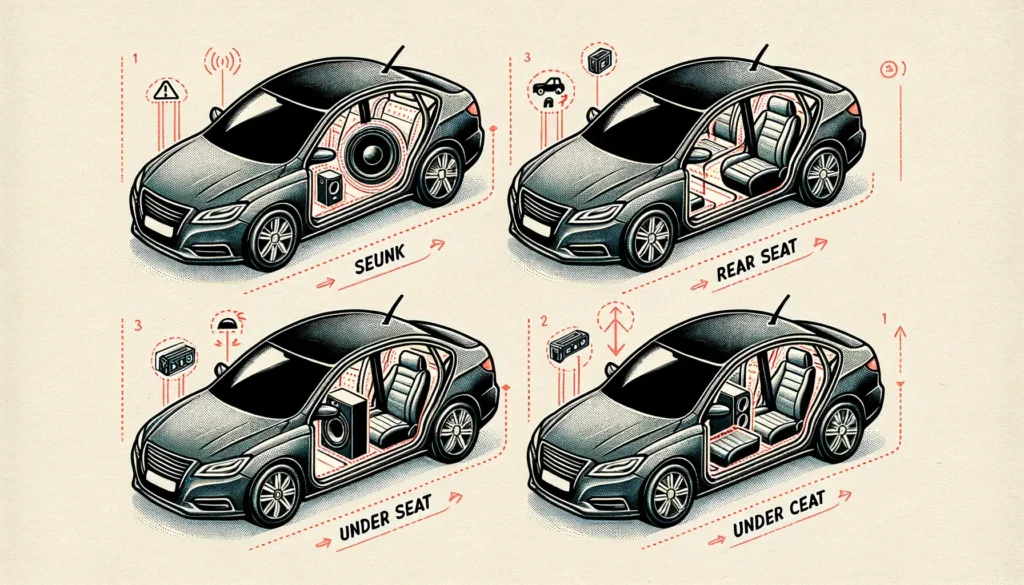
When enhancing the audio experience in your car, understanding how to setup car subwoofer is crucial. A subwoofer plays a pivotal role in bringing out the depth and power in your music, providing that rich, full bass sound that we all love.
You might be wondering why exactly setting up a car subwoofer properly is so important. Well, it boils down to achieving the highest quality of sound possible.
A well-tuned subwoofer doesn’t just add bass; it integrates seamlessly with your car’s audio system, enriching the listening experience and making every song you play sound right.
However, the advantages extend beyond just an improved listening experience. A balanced setup ensures that no particular part of the audio spectrum overpowers the others, resulting in clear, distortion-free sound at any volume level. This is especially crucial when you’re in the mood to turn up your favorite tunes and fully immerse yourself in the music.
Moreover, setting up your car subwoofer correctly can prolong the life of your car’s audio system. By handling low-frequency sounds, the subwoofer alleviates the burden on the rest of your speakers, helping them to work more efficiently and last longer.
So, whether you’re an audiophile aiming to achieve acoustic perfection in your vehicle or just someone who appreciates a great sound system, taking the time to learn how to setup car subwoofer is a worthwhile investment. In this article, we are excited to guide you through this process, ensuring you get the most out of your car’s audio system. Let’s dive in!
Key Takeaways
- A well-set subwoofer enriches your car’s overall audio experience.
- Proper subwoofer setup prevents audio distortion at all volume levels.
- Correctly installed subwoofers extend the life of your car’s speakers.
- Subwoofer placement is crucial for optimal sound quality in cars.
- Secure mounting of your subwoofer ensures safety and sound clarity.
- Precise wiring is essential for subwoofer performance and safety.
- Crossover settings are essential to balanced and clear audio output.
- Gain adjustments help harmonize subwoofer and speaker audio levels.
- Bass boost settings should be used sparingly for best results.
- Troubleshooting common subwoofer issues ensures lasting audio enjoyment.
How to Setup Car Subwoofer?
Setting up a car subwoofer requires precision and understanding of your car’s audio system. It’s not just about placing a box in your car’s trunk; it involves careful consideration of location, secure mounting, and proper wiring. Here’s a step-by-step guide to help you through the process:
Choosing the Right Location for Your Subwoofer

The location of your subwoofer in your car is pivotal in determining the quality of sound you’ll experience. Different cars and subwoofers require unique placements to achieve optimal performance.
- Trunk Placement: For sedans, the trunk is a common location for a subwoofer. Placing the subwoofer facing towards the car’s rear can result in a deeper bass, but experiment with different angles to find what sounds best.
- Rear Seat Placement: In hatchbacks or SUVs, placing the subwoofer against the rear seat, facing toward the front of the car, can yield good results.
- Under the Seat: Some smaller subwoofers can be placed under the car seats. This can save space but may limit the size and power of the subwoofer you can install.
- Consider the Subwoofer’s Design: Some subwoofers are designed to be placed in specific areas of your car for optimal performance. Make sure to read the manufacturer’s recommendations.
Mounting the Subwoofer
Securing your subwoofer is crucial to prevent damage and ensure it stays in place, even during a bumpy ride.

- Use a Subwoofer Box: A subwoofer box not only helps to protect your subwoofer but also enhances the sound quality. Make sure the box is securely fastened to your car.
- Anti-Vibration Materials: Use anti-vibration materials to prevent rattles and ensure a cleaner sound.
- Check for Loose Parts: Ensure all subwoofer parts are securely mounted and that nothing is loose.
Wiring the Subwoofer

Proper wiring is crucial for the performance and safety of your subwoofer.
- Connect to the Car’s Power Supply: Your subwoofer needs power. Connect it to the car’s battery, but ensure you have a fuse within 18 inches of the battery to prevent damage.
- Connect to the Stereo: Use a high-quality RCA cable to connect the subwoofer to your car’s stereo. Make sure the connections are secure and free from any interference.
- Grounding: Properly ground your subwoofer to prevent any electrical issues. Find a solid grounding point that is free of paint and rust.
- Setting the Gain: Use a multimeter to set the gain on your amplifier correctly. This ensures that your subwoofer and amplifier are working together efficiently, maximizing performance and minimizing distortion.
By carefully choosing the location, securely mounting your subwoofer, and ensuring proper wiring, you’ll be on your way to experiencing the best possible sound quality from your car’s audio system.
Remember to take your time, follow the manufacturer’s instructions, and don’t hesitate to seek professional help if needed. Enjoy the ride with your newly set up car subwoofer!
How to Tune a Car Subwoofer?

Tuning a car subwoofer is like giving your car’s audio system a little extra love so it can give you the best music experience possible.
When we talk about tuning a subwoofer, we’re mainly focusing on three things: setting the crossover, adjusting the gain, and tweaking the bass boost. Let’s dive in and make sure you can enjoy every beat of your favorite tunes!
Setting the Crossover
The crossover is like a traffic cop for sound. It tells the bass frequencies to go to the subwoofer and the other frequencies to the main speakers. When you set the crossover correctly, your music will sound balanced and clear.
- Find the Right Frequency: A good starting point is to set the crossover frequency at 80 Hz. This is a common setting that works well for many car audio systems. However, you might need to adjust this depending on your specific setup and personal preferences.
- Adjust as Needed: Listen to various music and observe how the bass sounds. If the bass sounds muddy or unclear, you might need to adjust the crossover frequency up or down until it sounds just right.
Adjusting the Gain
Adjusting the gain is like setting the right volume for your subwoofer. It’s not about making the bass as loud as possible but about ensuring it’s in harmony with the rest of your speakers.
- Start Low: Turn the gain knob down to start with.
- Turn Up the Music: Play a song with a steady bass and turn up your car’s main volume to its highest clean point (the point before the sound starts to distort).
- Find the Sweet Spot: Slowly turn up the gain on your subwoofer until the bass sounds balanced with the rest of the music. You’re looking for a rich, full sound—not something that overpowers everything else.
Adjusting the Bass Boost
The bass boost is like the cherry on top. It adds a little extra punch to the bass, but it’s important not to overdo it.
- Use Sparingly: Think of the bass boost as a special spice in cooking. A little can enhance the flavor, but too much can ruin the dish. Start with the bass boost at 0 and only add a little bit if you think it’s necessary.
- Listen Carefully: As you adjust the bass boost, listen closely to how it affects the sound. You want to add just enough to give the bass some extra punch but not so much that it sounds distorted or overwhelming.
By taking the time to tune your car subwoofer, you’re setting yourself up for a fantastic audio experience. Remember, it’s all about balance and finding the best settings for your specific car and personal taste. Happy tuning!
Troubleshooting and Common Issues

Even with the best efforts, sometimes things might not go as smoothly as we’d like while setting up and tuning a car subwoofer. Don’t worry! We’ve got your back. Let’s walk through some common problems that might pop up and how you can fix them.
The subwoofer is Not Producing Any Sound
- Check the Power: Ensure your subwoofer is correctly connected to a power source. If it’s not getting power, it won’t produce any sound.
- Inspect the Connections: Look at all the wires and connections. Make sure everything is securely plugged in and in the right place.
- Test the Source: Play audio from a different source to ensure the issue is not with the original audio file or device.
- Distorted or Muffled SoundAdjust the Gain and Bass Boost: If the gain or bass boost is set too high, it can cause the sound to distort. Try turning these down to find a clearer sound.
- Check the Crossover Settings: Ensure the crossover is set to the correct frequency. An improper setting can lead to sound distortion.
- Inspect the Subwoofer: Look for any visible damage to the subwoofer itself. Sometimes, physical damage can cause sound quality issues.
Subwoofer is Overheating
- Check Ventilation: Make sure the subwoofer has enough space around it for air to circulate and cool it down.
- Lower the Volume: If you’ve been playing music at a very high volume for an extended period, try lowering the volume to give your subwoofer a break.
The subwoofer Turns Off Suddenly
- Inspect the Power Source: Ensure the subwoofer is correctly connected to a reliable source.
- Check the Auto On/Off Setting: Some subwoofers have an auto on/off feature. Make sure it’s set according to your preference.
Rattling Noises
- Secure the Subwoofer: Make sure the subwoofer is securely mounted. Sometimes, a loose subwoofer can rattle and create noise.
- Check for Foreign Objects: Ensure there are no objects in or around the subwoofer that might be causing the rattling noise.
By addressing these common issues, you should be well on your way to enjoying crisp, clear bass from your car subwoofer. Remember, patience is key. Take your time to troubleshoot and adjust the settings until everything sounds just right. Happy listening!
FAQs
What is the best setting for a subwoofer in a car?
The optimal setting varies, but starting with a crossover around 80 Hz and adjusting the gain to balance with your speakers is a solid foundation.
How to set car subwoofer crossover frequency?
Start at 80 Hz and adjust up or down based on your preferences and the specific characteristics of your audio system and music genre.
Can you use a car subwoofer at home?
Yes, with the proper power supply and audio interface, you can connect and use a car subwoofer in your home audio setup.
How to hook up a car subwoofer in the house?
You’ll need a power inverter to convert home AC power to DC and an amplifier to connect the subwoofer to your home audio source.
Conclusion
As we’ve journeyed together through the ins and outs of How to Setup Car Subwoofer, it’s clear that this process is much more than just a technical task—it’s an art.
From choosing the perfect location to ensuring secure mounting to meticulous wiring, every step is a stroke of the brush toward achieving acoustic excellence in your vehicle.
Remember, the woofer isn’t just a box that makes your car shake; it’s the heart of your car’s audio system, pumping life and soul into your music. It’s about finding that sweet spot where the bass complements the melody, creating a harmonious and immersive listening experience.
When set up and tuned correctly, your subwoofer adds depth, power, and fullness to your music that makes every drive a concert on wheels.
We also delved into the crucial steps of tuning your subwoofer, emphasizing the importance of balance in settings such as the crossover, gain, and bass boost. Like a chef seasoning a dish, a little goes a long way, and precision is key.
And let’s not forget the invaluable troubleshooting tips. Sometimes, things don’t go as planned, but with patience and attention to detail, you can overcome common issues and get back to enjoying your music at its best.
So, setting up and tuning your car subwoofer is a journey worth taking. It’s an investment in your audio experience, ensuring every note hits just right and every drive is an experience to remember.
Remember, a well-tuned subwoofer is not just an accessory; it’s a gateway to a richer, more vibrant world of sound. Enjoy the ride, and happy tuning!






